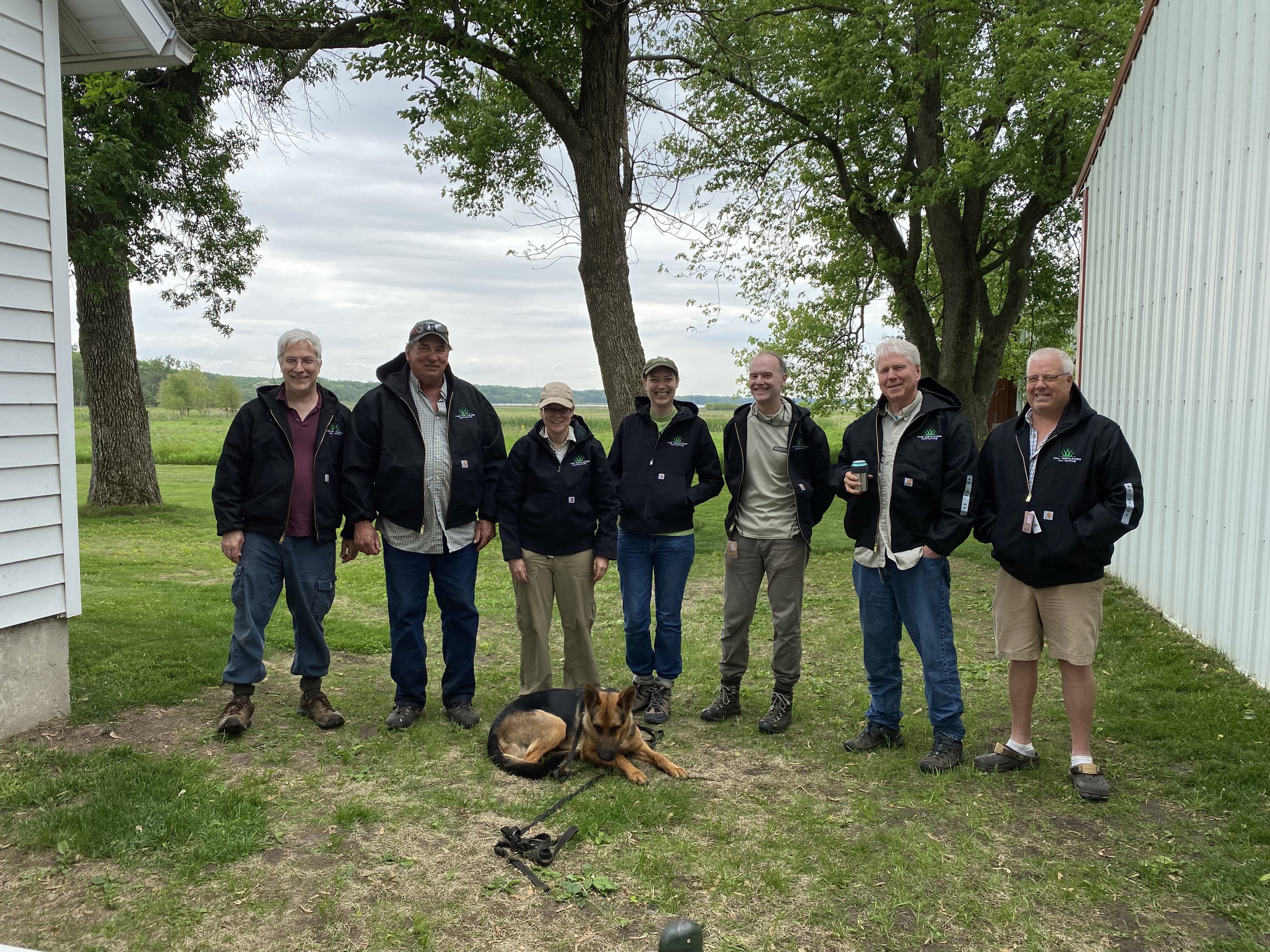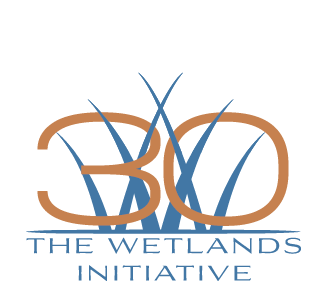Gary Sullivan looks out over the project that brought him to TWI twenty-three years ago, the beautiful Dixon Waterfowl Refuge.
This fall, we will be celebrating Dr. Gary Sullivan’s retirement and reflecting on his two-plus decades of work restoring wetlands in our region. As we look ahead to transitioning to a newly titled Restoration Program Director in the coming months, we at TWI are reflecting on Gary's impactful tenure at the organization. Gary knows about as well as anyone could how the Wetlands Initiative has grown and changed, because he’s been at the heart of it. In addition to his considerable skills and knowledge, Gary’s personal style and approach have been very important for that. For example the stories I’ve heard about how TWI got itself going on the ground at Midewin National Tallgrass Prairie sound exactly like the Gary Sullivan I’ve enjoyed knowing these past 13 years: visionary about what could and should be done while relentlessly practical about the here and now, with a lot of drive smoothed over by a warm and disarming manner.
When Gary talks about his start here, centered on carrying out a somewhat-implausible scheme which today we all know as the Dixon Waterfowl Refuge, I smile at a small irony. TWI at that time was a young organization operating in a classic startup “lone wolf” mode and we’ve all heard Gary recall that a bit wistfully. (“Waaay fewer meetings!”) But in reality he is a terrific and enthusiastic collaborator, which has been really important for TWI.
The title of Gary’s role is now changing to Restoration Program Director, which in large part simply acknowledges the role he’s built and now embodies. Gary is of course first and forever an ecologist. He’s also had little personal interest in things like job titles and position descriptions -- but now we insisted. The next person has to be clear about the dynamic and multi-faceted operation that Gary has created here. TWI needed that from him in order to successfully evolve from those startup days, and it’s what we’ll need from here for our impact to keep growing. No one can say it better than Gary himself, so please enjoy his own words of reflection which follow.
Paul Botts, President & Executive Director
Reflections from Outgoing Senior Ecologist
Dr. Gary Sullivan
I have recently discovered that contemplating retirement can be a bit unsettling. It leads to a lot of questions, most without answers, and not all of them comfortable. I have been employed now continuously since I received my undergraduate degree 50 years ago, and every summer before that going back to when I was 14. I have now been working in the field of ecology for over 40 years, and I don’t really feel that I’m quite ready yet to quit the stage. But unfortunately, Father Time is still undefeated, and I have three granddaughters that I see all too infrequently, and none of my immediate or extended family is in the Midwest, and I’m still not getting any younger. Few crossroads in life involve easy decisions, and this has been no exception.
So perhaps my biggest question is am I ready to leave TWI? Is the work I’ve started going to be in good hands? I have been a part of TWI for the past 23 years, and it’s the best job I’ve ever had. I feel unbelievably lucky for the opportunity to do such meaningful and rewarding work, and it is somewhat bittersweet knowing that I’ll be turning it all over to others to carry on in my stead. But I’m also very gratified to have so many different projects in various stages of either development or implementation to be turned over to the next generation of TWI ecologists. They will do well.
How has TWI changed during your tenure?
In a lot of ways, TWI is just getting started, at least, in this its latest incarnation. Twenty years ago, we were a small non-profit focused on restoring wetlands, primarily on the Illinois and Des Plaines River floodplains. We were somewhat opportunistic in choosing projects, working solo to design wetlands and enhance the removal of nutrients and improve water quality. Some of those projects were visionary and grand in scope, even if they weren’t always funded or implemented. One of them, my first major project for TWI, was to design and restore a 2,750-acre floodplain levied off from the Illinois River at Hennepin, Illinois. It is why I came to work at TWI, and I thought I’d add this to my resume and move on to somewhere else after five years or so. Over 20 years later, I’m still at TWI and that project has evolved into the 3,080-acre Sue and Wes Dixon Waterfowl Refuge, TWI’s flagship restoration and the most tangible and marketable example of our expertise. The Dixon Refuge established our bona fides to all of the partners and funders who have supported us so generously over the years.
Today, TWI is the conservation leader in wetland restoration in the Chicago Region. In addition to the Dixon Refuge, we are working in both Illinois and Indiana in the Calumet Region at eight different sites, at the Midewin National Tallgrass Prairie, and a host of Smart Wetlands around the state (smaller wetlands developed by Jill Kostel on farms and designed to remove nutrients, provide wildlife habitat, and return a portion of our natural heritage to the agricultural landscape). We partner with a wide range of organizations, providing them with expertise on developing, sustaining, and managing wetlands. Over the past 12 years or so, we have been able to restore more wetlands, achieve more goals, raise more funds, and reach more people than at any time in the earlier days of my tenure at TWI. It’s been my privilege to be a part of the organization’s growth and expansion, and the development of new and innovative methods for restoring wetlands and other habitats integral to healthy wetland landscapes. That, I will miss.
What were the biggest challenges during your time as Senior Ecologist – and how did you overcome them?
There have been a lot of challenges, and I’ve had a lot of help from very talented colleagues and partners in meeting them. Perhaps the most challenging was the removal of common carp from Hennepin and Hopper Lakes at the Dixon Refuge, which was a critical step in restoring the very high-quality, species-diverse, marsh and lake habitat that we have today. It took a lot of hard work, a number of wrong turns, and a lot of money spent over six years to learn how carp were able to foil all of our efforts to remove them and finally restore a healthy, dynamic lake and marsh system. Because we were successful, the Dixon Refuge is now recognized as a Ramsar Wetland of International Importance, serving as a mecca for wetland-dependent wildlife and especially migratory waterfowl, and for the people that love to come and experience a part of what Illinois was like over 200 years ago.
What excites you most about TWI’s projects right now?
The scope of the various different projects we are doing. They are all different and challenging in different ways. We are restoring a massive lake and hemimarsh system at Square Marsh; re-meandering rivers on the Little Calumet River in Indiana; restoring prairie, wetland, and riparian habitat at Midewin; recontouring marshes at Indian Ridge Marsh; adding a new sand prairie restoration at the Dixon Refuge; developing critical wetland infrastructure for the woefully underserved community at Marshalltown in Gary, Indiana; and exploring a new ‘brownfield’ restoration on the shores of Wolf Lake. This new exciting work will keep TWI relevant in the Chicago region for years to come.















